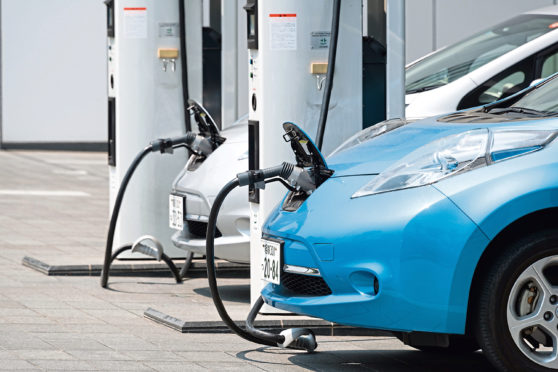Free use for electric car drivers from Aberdeenshire Council’s charging points could come to an end if new recommendations to cover costs are approved.
There are currently more than 50 charging points in communities throughout Aberdeenshire for drivers of electric vehicles (EV) to top up their batteries and, in recent years, there has been a sharp increase in their use.
The charging units, which have been introduced free of use in the region to encourage green transport, were employed 17,000 times in 2017-18, but over the last 12 months that number has spiralled to 25,000.
With their use becoming more popular, Aberdeenshire Council is now considering charging £0.21 per kwH to help cover the costs of operating its public EV charge points.
Under the new model, drivers of EVs such as the Nissan Leaf, which has a battery size of 40kwh and can cover 150 miles on a charge, would need to pay £8.40 to fill up at a council-owned charger.
Other vehicles, such as the Tesla Model S 100D, which has a 100kwh battery and can travel 320 miles, would cost £21 to top up.
A report from Stephen Archer, director of infrastructure services at Aberdeenshire Council, said: “Given the wider strategic commitments to decarbonise the transport network in line with climate change targets that will see an ongoing expansion of the public EV charging network, the costs associated with operating and maintaining the charge points will also continue to increase.
“Whilst the initial provision of this electricity at no cost will have aided the initial move to EV use, continuing to cover the costs of the electricity consumed along with ongoing maintenance costs will create an increasing pressure on the council budget.”
Council officers looked at a number of options for passing the cost on to EV drivers, such as charging a flat rate regardless of the amount of energy used in a charge, or a flat rate as well as a cost per unit of electricity consumed.
However, the recommended option which councillors will consider next week is to charge drivers purely based on how much they use, as it was considered by officers as “the most equitable” model.
Transport Scotland has already agreed to cover the average maintenance cost of Aberdeenshire’s charging points of around £16,000 a year for the next three years, so the new fees would only come into force from March 2022, if approved.










